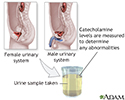Catecholamines - urine
Dopamine - urine test; Epinephrine - urine test; Adrenalin - urine test; Urine metanephrine; Normetanephrine; Norepinephrine - urine test; Urine catecholamines; VMA; HVA; Metanephrine; Homovanillic acid (HVA)
Catecholamines are chemicals made by nerve tissue (including the brain) and the adrenal gland.
The main types of catecholamines are dopamine, norepinephrine, and epinephrine. These chemicals break down into other components, which leave your body through your urine.
A urine test can be done to measure the amount of catecholamines produced by your body. Separate urine tests may be done to measure related substances.
Catecholamines can also be measured with a blood test.
How the Test is Performed
For this test, you must collect your urine in a special bag or container every time you urinate for a 24-hour period.
- On day 1, urinate over the toilet when you wake up in the morning and discard that urine.
- Urinate into the special container every time you use the bathroom for the next 24 hours. Keep it in the refrigerator or a cool place during the collection period.
- On day 2, urinate into the container in the morning again when you wake up.
- Label the container with your name, the date, the time of completion, and return it as instructed.
For an infant, thoroughly wash the area where urine exits the body.
- Open a urine collection bag (a plastic bag with an adhesive paper on one end).
- For males, place the entire penis in the bag and attach the adhesive to the skin.
- For females, place the bag over the labia.
- Diaper as usual over the secured bag.
This procedure may take a few tries. An active baby can move the bag causing urine to go into the diaper.
Check the infant often and change the bag after the infant has urinated into it. Drain the urine from the bag into the container provided by your health care provider.
Deliver the sample to the laboratory or to your provider as soon as possible.
How to Prepare for the Test
Stress and heavy exercise may affect the test results.
Some foods can increase catecholamines in your urine. You may need to avoid the following foods and beverages for several days before the test:
- Bananas
- Chocolate
- Citrus fruits
- Cocoa
- Coffee
- Licorice
- Tea
- Vanilla
Many medicines can interfere with test results.
- Your provider will tell you if you need to stop taking any medicines before you have this test.
- Do not stop or change your medicines without talking to your provider first.
How the Test will Feel
The test involves only normal urination, and there is no discomfort.
Why the Test is Performed
The test is usually done to diagnose an adrenal gland tumor called pheochromocytoma. It may also be used to diagnose neuroblastoma. Urine catecholamine levels are increased in most people with neuroblastoma.
The urine test for catecholamines may also be used to monitor those who are receiving treatment for these conditions.
Normal Results
All of the catecholamines are broken down into inactive substances that appear in the urine:
- Dopamine becomes homovanillic acid (HVA)
- Norepinephrine becomes normetanephrine and vanillylmandelic acid (VMA)
- Epinephrine becomes metanephrine and VMA
The following normal values are the amount of the substance found in the urine over a 24-hour period:
- Dopamine: 65 to 400 micrograms (mcg)/24 hours (420 to 2612 nmol/24 hours)
- Epinephrine: 0.5 to 20 mcg/24 hours
- Metanephrine: 24 to 96 mcg/24 hours (some laboratories give the range as 140 - 785 mcg/24 hours)
- Norepinephrine: 15 to 80 mcg/24 hours
- Normetanephrine: 75 to 375 mcg/24 hours
- Total urine catecholamines: 14 to 110 mcg/24 hours
- VMA: 2 to 7 milligrams (mg)/24 hours (10 to 35 mcmol/24 hours)
Normal value ranges may vary slightly among different laboratories. Talk to your provider about the meaning of your specific test results.
The examples above show the common measurements for results for these tests. Some laboratories use different measurements or may test different specimens.
What Abnormal Results Mean
Elevated levels of urinary catecholamines may indicate:
- Acute anxiety
- Ganglioneuroblastoma (very rare)
- Ganglioneuroma (very rare)
- Neuroblastoma (rare)
- Pheochromocytoma (rare)
- Severe stress
The test may also be performed for:
Risks
There are no risks.
Considerations
Several foods and drugs, as well as physical activity and stress, can affect the accuracy of this test.
References
Gruber HA, Oprea M. Russell YX. Evaluation of endocrine function. In: McPherson RA, Pincus MR, eds. Henry's Clinical Diagnosis and Management by Laboratory Methods. 24th ed. Philadelphia, PA: Elsevier; 2022:chap 25.
Young WF. Adrenal medulla, catecholamines, and pheochromocytoma. In: Goldman L, Schafer AI, eds. Goldman-Cecil Medicine. 26th ed. Philadelphia, PA: Elsevier; 2020:chap 215.
Female urinary tract - illustration
Female urinary tract
illustration
Male urinary tract - illustration
Male urinary tract
illustration
Catecholamine urine test - illustration
Catecholamine urine test
illustration
Review Date: 4/30/2021
Reviewed By: David C. Dugdale, III, MD, Professor of Medicine, Division of General Medicine, Department of Medicine, University of Washington School of Medicine. Also reviewed by David Zieve, MD, MHA, Medical Director, Brenda Conaway, Editorial Director, and the A.D.A.M. Editorial team.










